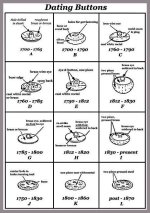lrgoodger
Full Member
- May 2, 2023
- 154
- 1,253
- Detector(s) used
- Whites 6000-D, Garrett GTA-1000, Minelab Sovereign, XP Deus I, Equinox 800, XP Deus II
This was 6" deep at the 'hunted out yard' where the 1876 quarter was only 2" deep. As you can see in the on-edge view, it is much thicker in the center than on the edges. It is .719" in diameter. It appears to be brass. There are no markings on either side. There is a post on the back that is almost 1/4" in diameter. There are no threads in it, but it looks like it has a screwdriver slot at the bottom. It looks like a hole was drilled in the post from the side (but did not go through the far side) and the stem it was on broke off through the hole. My guess is there was a pin in the hole holding it onto whatever it was on.













